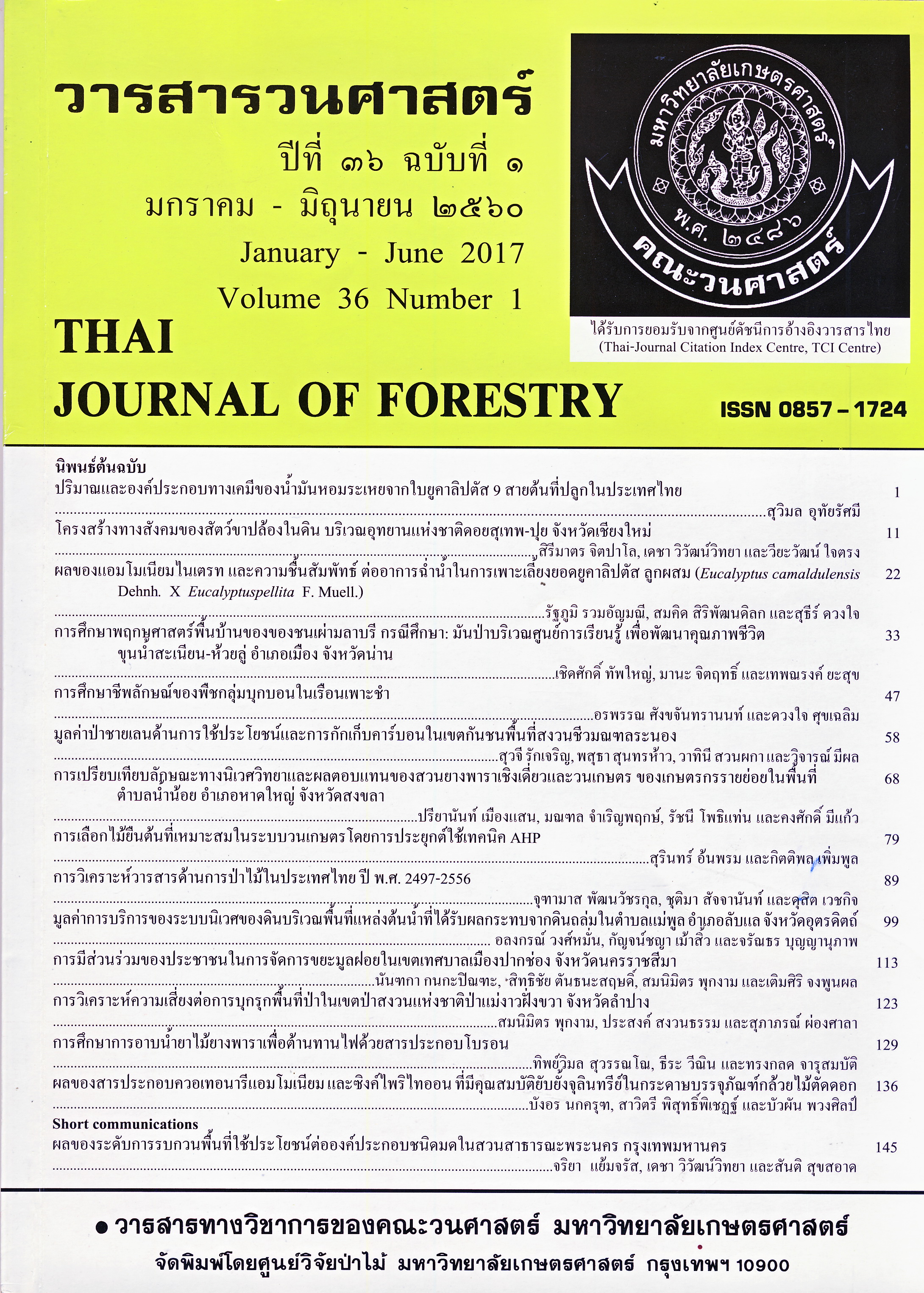มูลค่าป่าชายเลนด้านการใช้ประโยชน์และการกักเก็บคาร์บอนในเขตกันชน พื้นที่สงวนชีวมณฑลระนอง
Main Article Content
บทคัดย่อ
วัตถุประสงค์เพื่อศึกษาปริมาณและมูลค่าการใช้ประโยชน์ทรัพยากรธรรมชาติในป่าชายเลนทั้งทางตรงและทางอ้อม พร้อมทั้งเสนอแนะแนวทางการจัดการป่าชายเลนเพื่อความยั่งยืน โดยใช้วิธีการศึกษาควบคู่กันระหว่างการสัมภาษณ์ผู้ใช้ประโยชน์ป่าชายเลนและการสำรวจป่า หลังจากนั้นวิเคราะห์ข้อมูลด้านปริมาณและมูลค่าการใช้ประโยชน์ป่าชายเลนจากราคาตลาดในท้องถิ่น และราคาตลาดนานาชาติสำหรับมูลค่าการใช้ประโยชน์ทางตรงและทางอ้อม ตามลำดับ ตลอดทั้งจัดทำข้อเสนอแนะการบริหารจัดการพื้นที่ด้วยเทคนิคการวิเคราะห์จุดแข็ง จุดอ่อน โอกาส ข้อจำกัด และการวิเคราะห์ในรูปแบบความสัมพันธ์แบบเมตริกซ์ (SWOT analysis และ TOWS matrix)
ผลการศึกษาพบว่าทรัพยากรป่าชายเลนถูกนำมาใช้ประโยชน์มากที่สุด ได้แก่ แมงกะพรุน รองลงมา คือ กุ้งแชบ๊วย กุ้งเคย ปูดำ กุ้งมังกร เป็นต้น รวมปริมาณทั้งหมด 2,634 กิโลกรัม/ ปี คิดเป็นมูลค่า เท่ากับ 11,864,000 บาท/ปี ซึ่งเป็นมูลค่าการใช้ประโยชน์ทางตรง ส่วนมูลค่าทางอ้อม คือมูลค่าการกักเก็บคาร์บอน คำนวณจากปริมาณมวลชีวภาพเฉลี่ย 25.00 ตัน/ไร่ ปริมาณการดูดซับคาร์บอนไดออกไซด์เฉลี่ย 43.10 ตันคาร์บอนไดออกไซด์/ไร่ คิดเป็นมูลค่าการกักเก็บคาร์บอนเฉลี่ย เท่ากับ 10,692 บาท/ไร่ ประเมินที่ระดับราคาคาร์บอนของตลาดสหภาพยุโรป (EUA) ในปี พ.ศ.2557 (6.24 EUR/tCO2) หรือมีมูลค่าการกักเก็บคาร์บอนเท่ากับ 353,360,775 บาท ดังนั้น มูลค่ารวมทั้งทางตรงและทางอ้อมของป่าชายเลนแห่งนี้ เท่ากับ 365,224,775 บาท และผลการศึกษายังได้นำมาซึ่งข้อเสนอแนะว่าควรสร้างแหล่งอนุบาลสัตว์น้ำ ปลูกเสริมป่าชายเลนด้วยพรรณไม้ท้องถิ่นดั้งเดิม ตั้งกฎระเบียบการทำประมงอย่างมีส่วนร่วม และจัดตั้งกองทุนสะสมทรัพย์สำหรับชาวประมง เพื่อการจัดการป่าชายเลนผืนนี้ให้เกิดความยั่งยืน
Downloads
Article Details
ข้าพเจ้าและผู้เขียนร่วม (ถ้ามี) ขอรับรองว่า ต้นฉบับที่เสนอมานี้ยังไม่เคยได้รับการตีพิมพ์และไม่ได้อยู่ในระหว่างกระบวนการพิจารณาตีพิมพ์ลงในวารสารหรือสิ่งตีพิมพ์อื่นใด ข้าพเจ้าและผู้เขียนร่วม (ถ้ามี) ยอมรับหลักเกณฑ์และเงื่อนไขการพิจารณาต้นฉบับ ทั้งยินยอมให้กองบรรณาธิการมีสิทธิ์พิจารณาและตรวจแก้ต้นฉบับได้ตามที่เห็นสมควร พร้อมนี้ขอมอบลิขสิทธิ์ผลงานที่ได้รับการตีพิมพ์ให้แก่วารสารวนศาสตร์ คณะวนศาสตร์ มหาวิทยาลัยเกษตรศาสตร์ กรณีมีการฟ้องร้องเรื่องการละเมิดลิขสิทธิ์เกี่ยวกับภาพ กราฟ ข้อความส่วนใดส่วนหนึ่ง หรือ ข้อคิดเห็นที่ปรากฏในผลงาน ให้เป็นความรับผิดชอบของข้าพเจ้าและผู้เขียนร่วม (ถ้ามี) แต่เพียงฝ่ายเดียว และหากข้าพเจ้าและผู้เขียนร่วม (ถ้ามี) ประสงค์ถอนบทความในระหว่างกระบวนการพิจารณาของทางวารสาร ข้าพเจ้าและผู้เขียนร่วม (ถ้ามี) ยินดีรับผิดชอบค่าใช้จ่ายทั้งหมดที่เกิดขึ้นในกระบวนการพิจารณาบทความนั้น”
เอกสารอ้างอิง
วิจารณ์ มีผล. 2553. การเก็บกักคาร์บอนของป่าชายเลนบริเวณพื้นที่สงวนชีวมณฑลระนอง. วารสารการจัดการป่าไม้ 4 (7): 29-44.
องค์การบริหารจัดการก๊าซเรือนกระจก. 2558. คู่มืออ้างอิงการพัฒนาโครงการลดก๊าซเรือนกระจก ภาคสมัครใจตามมาตรฐานของประเทศไทย สาขาป่าไม้และการเกษตร, กรุงเทพฯ.
อภิชัย ศรีเมือง. 2555. SWOT: เทคนิควิเคราะห์ธุรกิจอย่างเฉียบคม (สไตล์ผู้บริหารมืออาชีพ). ธิงค์ บียอนด์ บุ๊คส์, นนทบุรี.
English, S., C. Wilkinson and V. Baker. 1997. Survey manual for tropical marine resources. 2nd Edition. Aust. Inst. Sci.
IPCC. 2006. IPCC Guidelines for National Greenhouse Gas Inventories. International Panel on Climate Change. IGES, Japan.
Komiyama, A., K. Ogino, S. Aksornkoae and S. Sabhasri. 1987. Root biomass of a mangrove forest in southern Thailand. 1. Estimation by the trench method and the zonal structure of root biomass. J. Trop. Ecol. 3: 97-108.
Krejicie, R. and E. Morgan. 1970. Education and Psychological Management. 608-609.
Walters, B.B., P. Ronnback, J.M. Kovacs, B. Crona, S.A. Hussain, R. Badola, J.H. Primavera, E. Barbier and F. Dahdouh-Guebas. 2008. “Ethnobiology, socio-economics and management of mangrove forests: A review.” Aquatic Botany.


